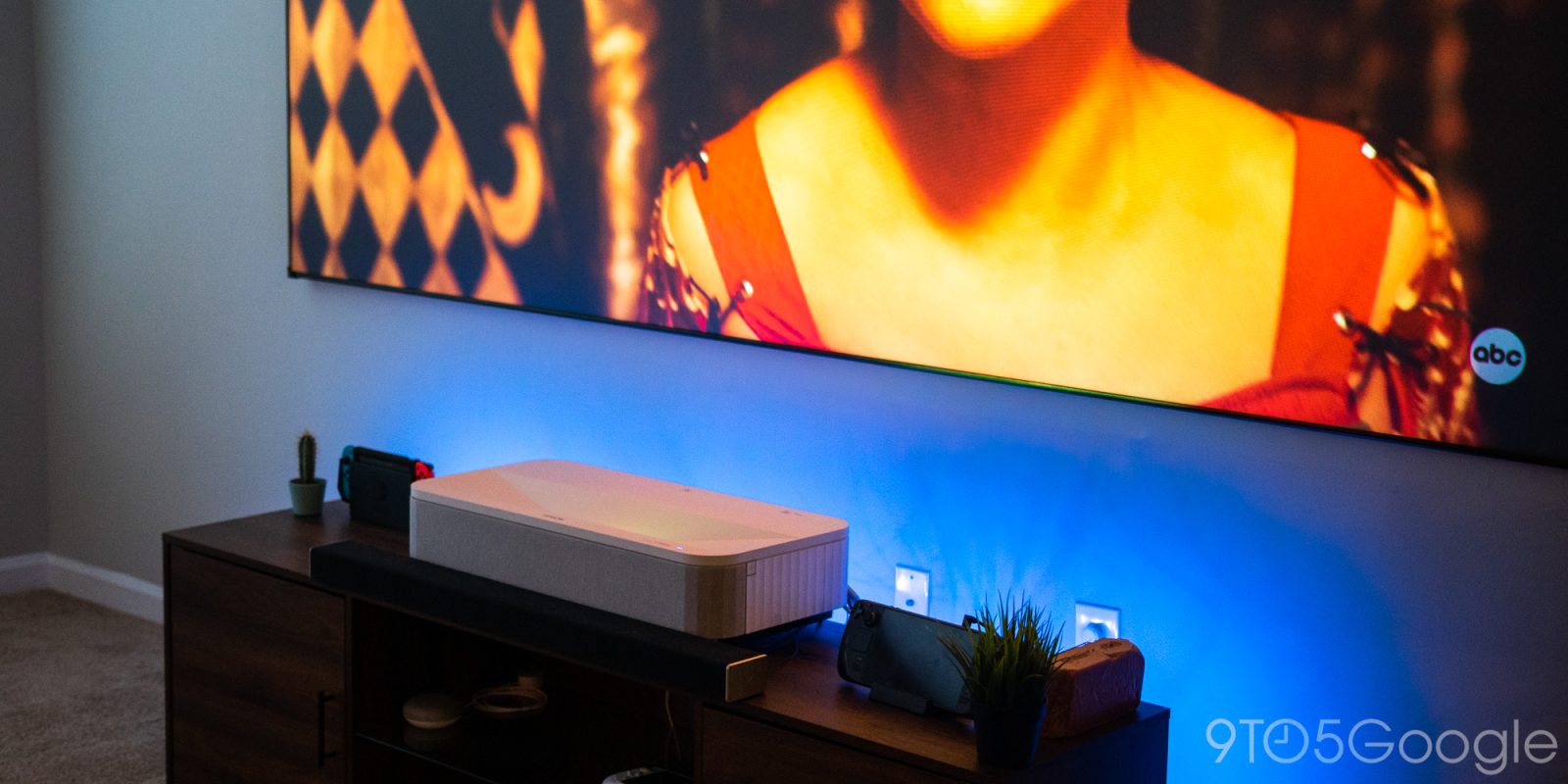
At tremendous speed, short-throw projectors are catching up in quality to high-end TVs, giving you a bigger screen with rivaling quality. The Epson LS800 is one of the best short throw projectors around, though if you’re looking to make the switch, there are a few things to note.
Exponentially increasing your screen size
When you think about a home theater projector, the first thing that may come to mind is a traditional unit that sits at the back of the room and lights up the wall opposite with your content. That traditional projector is called a long-throw projector and is much simpler in construction.
An ultra-short-throw projector (UST), however, sits right under the screen or wall you’re projecting onto. The angle at which it lights up the screen is much more acute, meaning you can set the projector on a TV unit or table only inches from the wall. Of course, each UST projector shoots images up at slightly different angles, with some needing more space from the wall than others.
The Epson LS800, however, has one of the best throw ratios around. With the front of the projector sitting at just 17.3 inches from the wall, you can get a 100-inch 16:9 image with ease. As far as throw ratios go, that’s one of the better ones on the market. This stands true whether or not you mount it from the ceiling or sit it on a TV stand.

Just a little farther out, and you’re looking at a 120-inch display, which is the setup I tested the Epson LS800 with. For reference, an 85-inch TV has an area of around 3,000 square inches. When compared to 120 inches, you’re increasing that area by effectively double, at 6,000 square inches, give or take. As it stands, an 85-inch display is already massive, and when pricing TVs with that size in mind, you’re going to spend a pretty penny anywhere from $2,000 to $4,000.
Warning – boring math time: At $1,500 for a hypothetical lower-end 85-inch TV, you’re looking at about $0.48 per square inch of the 3,087 square-inch display. If you were to apply that cost to a 120-inch display, it would cost you around $3,000 or more to get a low-end 120-inch TV, not even factoring in the difficulty of building a 120″ panel and the cost of doing so. The better quality, the more you’ll spend, and you can imagine how much that could come out to.
Realistically, 120 inches is absolutely massive, and you should only aim for that screen size if you have the space to do so. But the idea is solid – at the cost per inch of display, a UST projector is arguably cheaper and more convenient with a potentially massive image of the same quality.
On that same note of realism, you’ll also want to consider that the 4K Epson LS800 shoots the same resolution, no matter the size of the display. The bigger the image, the more those pixels are spread across the screen or wall. I found that 100 inches is the perfect display size, no matter how far away you sit, with 120 inches feeling a little too large if you have a smaller living room.
With that size, those pixels can seem a little blurry, even when in focus perfectly. Back yourself up, and it becomes crisp and clear – simply a matter of space between you and the screen. On top of that, you’re also much more likely to notice content at lower resolutions, with anything under 720p being absolutely unwatchable at that size.
Build and laser performance
The Android TV-powered Epson EpiqVision LS800 is a gorgeous projector, and it has to be. Unlike long-throw units, the UST projector sits on a cabinet right in your line of sight. Having an ugly unit can bring down the space, especially under a large display.
The front of the LS800 is covered in a cloth screen to hide the Yamaha speakers underneath. Beyond that, the casing is made of plastic – white or black. On the right side and under an adjustable cover sits 3 HDMI 2.0 ports (1 ARC and 1 Gaming). Along with that, you have the option to plug in an optical audio cable and a 3.5mm tie-in. The LS800 makes use of HDMI CEC, so you can ensure remotes for other devices control power and sound without issue.
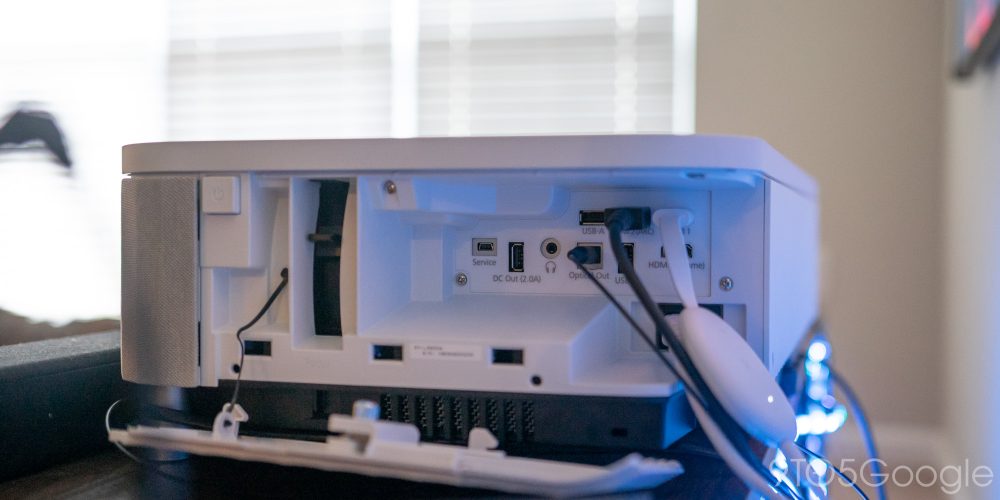


Underneath are three legs, with the two in the front being on either side while the rear sits centrally with a larger footprint. All three are adjustable, allowing you to square up your projector display with a screen before making smaller adjustments.
One of the best features that the Epson LS800 has to offer is its screen correction suite. The easiest way is to use the Epson app on Android to take a photo of your screen and allow it to adjust itself. It isn’t perfect, with small adjustments needed after, though it’s mostly accurate. If you don’t want to do that, you can also use the four-point keystone correction tool to square up the screen.
At 4,000 ANSI lumens, the Epson LS 800 is bright. Many UST projectors come in at around 2,000 or 3,000, while the Epson LS800 blows most of them out of the water in that regard. With an ALR (ambient light rejection) screen, you’re going to be able to watch content no matter what time of day, so long as you don’t place the screen next to south-facing bay windows – like myself.
Even then, the LS800 is perfectly watchable midday, with minimal screen quality loss. I paired the EpiqVision with Epson’s 120-inch SilverFlex ALR screen, which does a fantastic job of rejecting ambient light. Of course, light that comes from below and the side will be much harder for the screen to bounce away, though it still does a surprising job. On the surface, an ALR screen has small ridges that catch light coming from below. Any light from above won’t bounce back at you, effectively making the projection much brighter.
Internally, the LS800 has a three-chip 3LCD system – a complicated array of mirrors and lenses that brings three primary color lasers together to display an accurate picture. With that, the Epson EpiqVision LS800 does a phenomenal job of accurate color reproduction, with only minimal tweaking necessary. The shadows and blacks are still filled with detail while the rest of the scene remains well-represented. In some respects, whites and lighter colors can appear a little too bright, though that’s a product of projectors in general.
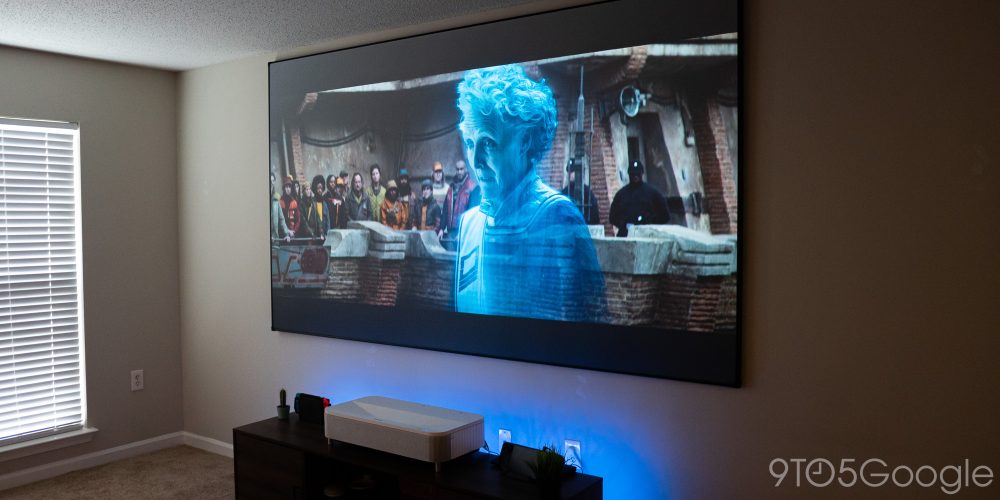
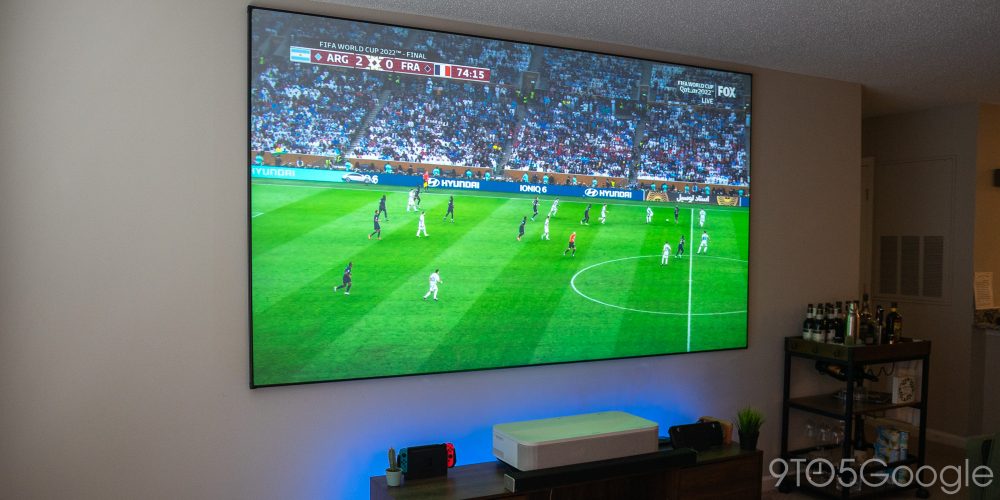
When watching content in 4K with HDR10, the LS800 truly shines and makes you realize how incredible having a cinema-sized display in a high resolution is. While low-res content is much more unbearable, movies and shows in 1080p or 4K stand out wonderfully, with detail being exactly where it should be. Not once did I experience the rainbow effect common with lower-end projectors, which bodes well for all-day viewing.
Of course, the innate brightness has a major side effect – heat. To combat that, the LS800 has a set of cleanable fans that cool the device down during runtime. While it isn’t quiet, I did find myself immediately forgetting it existed once I started watching something. When others visited to watch a movie, the fan noise was the first noticeable thing, though it became much less of a bother after a couple of minutes. While that isn’t a dealbreaker, it’s something to be well aware of.
Powered by Android TV
What makes the EpiqVision LS800 so easy to set up is the built-in Android TV. With a native OS that just works well and is familiar, getting content up and running is simple and easy to do. I found that even plugging in a Chromecast with Google TV or Nvidia Shield Pro with Android TV just didn’t give me the same experience as the native version.
Content feels sharper and clearer when using the built-in Android system. On top of that, some options, like noise reduction, are only accessible when using the native OS. Android TV as a whole on the LS800 is fast and reliable. Getting in and out of streaming apps like Peacock and YouTube TV is snappy and easy.
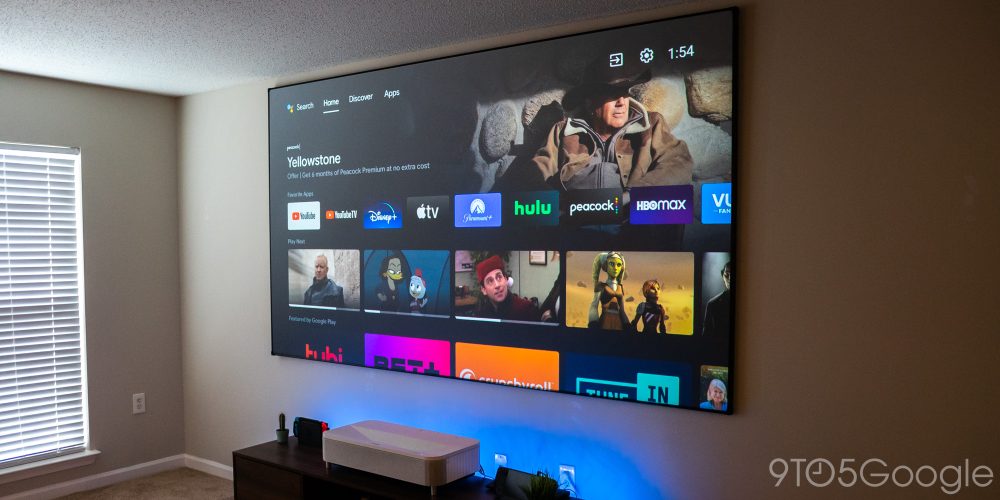
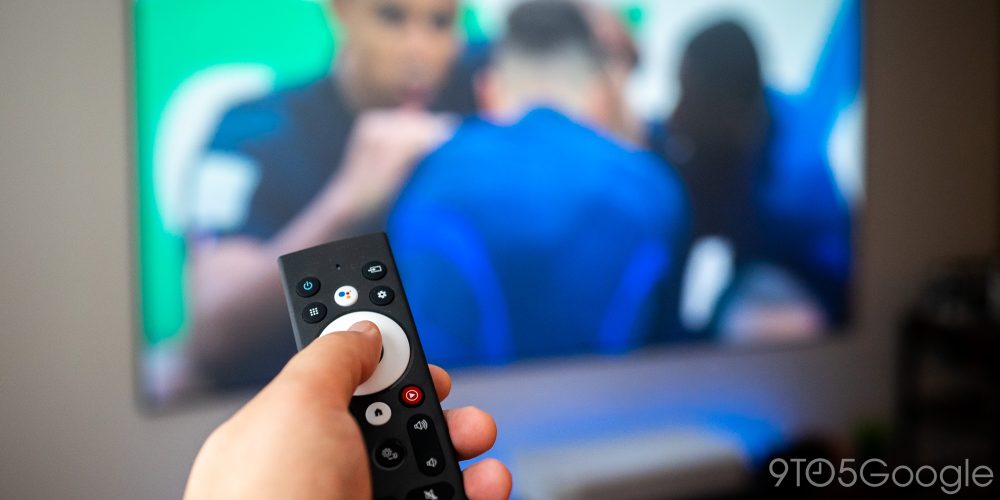
The remote that comes with the LS800 is nice, though it feels a little too light for my liking. Besides that, the function of it comes in handy for viewing Android TV right on the projector. It also has a few options toward the bottom for on-the-fly screen corrections, though for most adjustments, you’ll want to use the dedicated projector settings button.
Unimpeded gaming on a huge screen
The third HDMI port is meant specifically for game consoles and other devices, like a cloud-capable Android TV or Google TV unit. With that, you get 60 frames per second with very minimal input lag.
While I don’t have specific timing on hand, I noticed absolutely no lag on the part of the projector. Cloud games innately have some, even through GeForce Now. When trying the Nintendo Switch, there was no lag to be seen, with the 120-inch screen lending itself perfectly to a four-player round of Mario Kart split-screen.
I did try using my Steam Deck with a third-party dock, though my experience wasn’t nearly as good. The Steam Deck was prone to cutting out randomly for one or two seconds at a time, which lent itself to an unplayable device. Beyond that, I had no issues with any other device at all.
As a gaming experience goes, the Epson LS800 paves the way for incredible sessions. With a massive screen and well-balanced visual quality, the UST projector finds itself as one of the better ways to play any title.
Final thoughts
In all, the Epson EpiqVision LS800 is a great UST projector – maybe the best one around. While UST projectors aren’t very old, they’ve come a very long way in a short time. With as bright as it is, it’s easy to see how this could replace a TV with ease, no matter what time of day you watch.
What truly sells me is the ease of setup and use. The LS800 doesn’t need a ton of space for a 120-inch image. Shrink to a whopping 100 inches, and you need even less. On top of that, Android TV built-in means you don’t need any extra devices, and even if you did opt for one, you’re likely not getting a better experience.
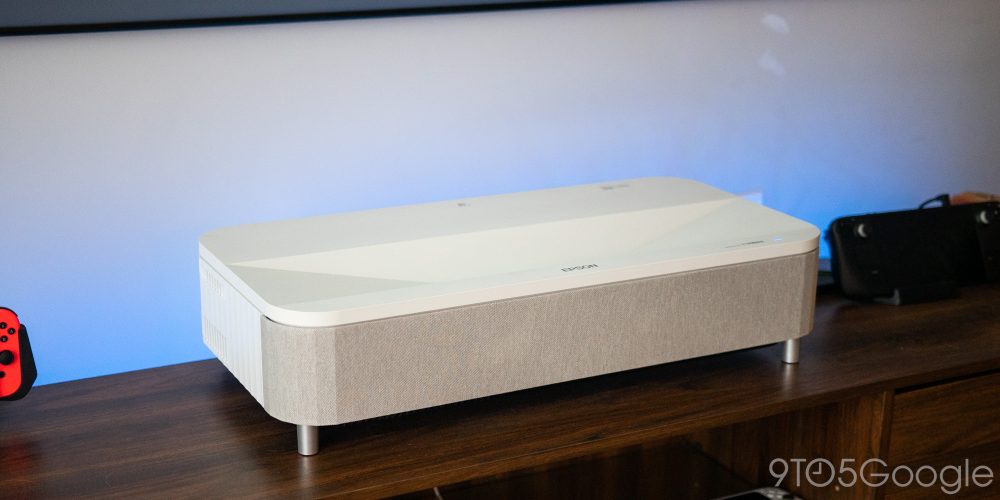
The potentially massive 4K HDR10 image you can get is purely a winning situation, and the Epson LS800 truly delivers. Of course, a high-end unit like the EpiqVision LS800 doesn’t come cheap – $3,499. Pair that with a high-end ALR screen, and you’re looking at even more, though there are some cheaper options out there that work very well.
It really comes down to what you’re looking for. Do you want an easy-to-use UST projector with minimal effort to set up? Do you want to expand to 100 inches or more? The LS800 can max out at 150 inches, though that’s ridiculous. If so, the EpiqVision LS800 is your best bet, giving you one of the best UST projector experiences available right now.
Where to buy the Epson EpiqVision LS800
Where to buy the Epson SilverFlex ALR screen – $3,000
Where to buy the WEMAX ALR screen – $500
FTC: We use income earning auto affiliate links. More.



Comments